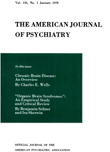AN ELECTROENCEPHALOGRAPHIC AND CLINICAL STUDY OF CHILDREN WITH PRIMARY BEHAVIOR DISORDERS
Abstract
1. The literature pertaining to EEG and clinical studies of children with behavior disorders is reviewed and special attention is given to techniques of recording and evaluating EEGs, diagnostic classification of children, and the findings of various investigators.
2. A manual counting technique for EEG evaluation is described.
3. EEG and clinical studies of 42 boys in the age range of 6-12 are presented, including 20 children with neurotic traits, 16 with conduct type disorder, and 6 childhood schizophrenics. Evaluation of EEGs by frequency counting and "inspection" methods is reported with attention to hyperventilation response. Clinical data concerning family history of mental illness, type of home care and parental attention, history of significant illness and injury, presence of enuresis, fire-setting, and stealing as well as intelligence quotients are presented. Relationship of this material to clinical classification and EEG normality or abnormality is presented.
4. There is a discussion of the clinical and theoretical significance of this material.
Access content
To read the fulltext, please use one of the options below to sign in or purchase access.- Personal login
- Institutional Login
- Sign in via OpenAthens
- Register for access
-
Please login/register if you wish to pair your device and check access availability.
Not a subscriber?
PsychiatryOnline subscription options offer access to the DSM-5 library, books, journals, CME, and patient resources. This all-in-one virtual library provides psychiatrists and mental health professionals with key resources for diagnosis, treatment, research, and professional development.
Need more help? PsychiatryOnline Customer Service may be reached by emailing [email protected] or by calling 800-368-5777 (in the U.S.) or 703-907-7322 (outside the U.S.).



